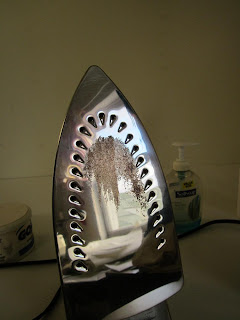Honestly, I thought Dad was making popcorn at 11:00 a.m.
I even had it set on Polyester.
So, before I go any farther & you think the following is how you should do this, just go get yourself some Barkeeper's Friend, Faultless hot iron cleaner, or some other product specifically designed to clean irons. I hear fine steel wool is also helpful.
Don't try what you're about to see at home...
BUT if you want to giggle, read on...
 |
| THIS is what happened to my nice iron. NOT happy. |
 |
| Calling in the troops I had on hand. Windex, Goo Gone, Dawn (incognito), Gojo and Paper towels. |
 |
| After 3 applications of Goo Gone, I switched to Gojo & things started chipping off. |
 |
| Following the Gojo was Dawn. She worked for a bit, then quit. |
 |
| Slightly better after fingernail scraping for an hour. |
 |
| Now, after fingernail scraping for an hour, a person gets pretty frustrated. Yes, that's a small screw driver. |
 |
| More Gojo. |
 |
| After about 8 Gojo/Dawn/screwdriver/Windex sessions, we now have a clean iron. A bit scraped up, but usable until I get to buy a new one. 2 hours later. |
 |
| See this black crap? That's melted nylon on my cotton pressing cloth. |
Just as an FYI, it's perfectly legal to have up to a 15% blend in wool & call it "100% wool"... in some cases it will be upwards of 30% depending on country of origin.
>>CougH, I woN't sAy where that comes from, cough<<
Anyway, it's legally wool, and at $18.00/yd it was a darn good lie.
Blends can be acrylic, nylon, polyester, rayon or any number of other fibers. They serve various purposes, mostly to help the wool be a more consistent fiber... until someone like me actually believes the fabric label & sets their iron on one-degree-less-than-required to press a seam and melts it all over the place.
Labels may lie, but irons do not.











